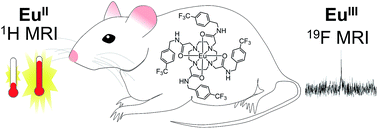Fluorinated EuII-based multimodal contrast agent for temperature- and redox-responsive magnetic resonance imaging†
Abstract
Magnetic resonance imaging (MRI) using redox-active, EuII-containing complexes is one of the most promising techniques for noninvasively imaging hypoxia in vivo. In this technique, positive (T1-weighted) contrast enhancement persists in areas of relatively low oxidizing ability, such as hypoxic tissue. Herein, we describe a fluorinated, EuII-containing complex in which the redox-active metal is caged by intramolecular interactions. The position of the fluorine atoms enables temperature-responsive contrast enhancement in the reduced form of the contrast agent and detection of the oxidized contrast agent via MRI in vivo. Positive contrast is observed in 1H-MRI with Eu in the +2 oxidation state, and chemical exchange saturation transfer and 19F-MRI signal are observed with Eu in the +3 oxidation state. Contrast enhancement is controlled by the redox state of Eu, and modulated by the fluorous interactions that cage a bound water molecule reduce relaxivity in a temperature-dependent fashion. Together, these advancements constitute the first report of in vivo, redox-responsive imaging using 19F-MRI.



 Please wait while we load your content...
Please wait while we load your content...